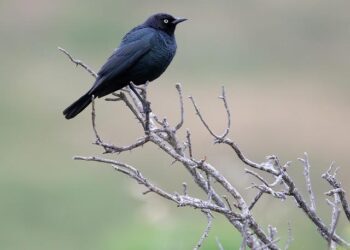Thescelosaurus wouldn’t have known that its world was about to change drastically. More specifically, that a seven-mile-wide asteroid barreling toward Earth would soon end life as we knew it at the time. The Age of Dinosaurs was about to come to an abrupt end.
Just before the K-T Event, 66 million years ago, Thescelosaurus would have lived alongside Triceratops, Tyrannosaurus rex, and Ankylosaurus in western North America. The species didn’t have many of the dazzling features like horns, a club tail, or a predilection to hunt other big dinosaurs that would have made it memorable.
In fact, its full name, Thescelosaurus neglectus, points to the fact that for many years, the species, which resembled an oversized chicken, was neglected and overlooked by scientists.
Super Sense of Smell
A new study published recently in Scientific Reports shows that the species had super senses that helped it survive right up until the end. Its powerful sense of smell was like none other in the animal kingdom.
This “acute olfaction and vestibular sensitivity,” as the study authors write, along with other characteristics, would have helped it survive by at least partially burrowing in the ground, says study author David Button, a vertebrae paleontologist at the University of Bristol in England.
As part of the research, Button calculated the species’ sense of smell using anatomical ratios in the brain cavity. “Relative to its body size, it had the biggest olfactory bulbs compared to any other dinosaurs known at this point,” says Button.
Thescelosaurus would have used this super sense of smell to help find food, and while we don’t have any preserved contents of its stomach to know what it ate for sure, it was likely tubers, roots, and seeds buried below the Earth’s surface.
It lived in a coastal plain in western North America, where vegetation was plenty but so were predators. Smell would have been especially important for survival as its hearing was less than optimal. Scent would have helped it escape the jaws of T. rex and other predators. It would also have been important underground to identify its young and other family members when there was little light to see.
Read More: Why Are Herbivore Dinosaurs Important, and What Can They Teach Us About Evolution?
A Burrowing Beast?
“Its forelimbs were quite powerful and could be used to dig, and its snout could have been used to root in the dirt,” says Button.
We don’t have any preserved burrows to prove that it lived underground, likely because its environment, which was much warmer than it is today, made such preservation difficult. Button says that it might have been adapted to live somewhere in between, like a Nile crocodile, for example, which digs deep holes but then uses them primarily to shelter its young.
“It at least had the capacity to dig holes. How much time it spent in them, we don’t know for sure,” says Button.
Knowing that dinosaurs may have burrowed is important because it indicates that dinosaurs could have lived in all sorts of ways.
“We think of dinosaurs as large terrestrial animals often represented with one type of lifestyle,” says Lindsay Zanno, study co-author and head of paleontology at the North Carolina Museum of Natural Sciences in Raleigh, North Carolina. “But the fact is, dinosaurs played a lot of ecological roles in the Cretaceous, just like modern mammals do today.”
Thescelosaurus’ neuroanatomy suggests that it either foraged or lived part of the time underground. But that didn’t seem to save it in the end. The suggestion has long been that mammals and birds survived because they were small and could seek shelter underground. But this species, which was adapted to burrow, fed on hearty and abundant underground resources, and was smaller than many dinosaur species, still died out with the Age of Dinosaurs.
Read more: A Complete Dinosaur Timeline to Extinction: How Long Did They Roam Earth?
Article Sources
Our writers at Discovermagazine.com use peer-reviewed studies and high-quality sources for our articles, and our editors review for scientific accuracy and editorial standards. Review the sources used below for this article:
Scientific Reports. Neuroanatomy of the late Cretaceous Thescelosaurus neglectus (Neornithischia: Thescelosauridae) reveals novel ecological specialisations within Dinosauria.
Natural History Museum. Thescelosaurus.
>>> Read full article>>>
Copyright for syndicated content belongs to the linked Source : Discover Magazine – https://www.discovermagazine.com/the-sciences/a-chicken-like-dinosaur-with-super-senses-finally-gets-the-attention-it































